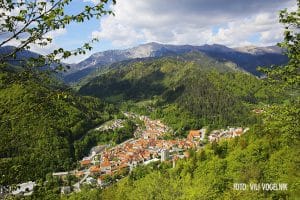From Proalp's workshop, News
WE ARE PROUD OF OUR SHOEMAKING TRADITION
Imagine a small, idyllic little town, surrounded by the Alps round and round. Through that town, the river passes by. In this little town, the best masters of shoemaking came from, and the life of its people was all about shoes. Can you imagine that almost every third person you know was somehow connected to the shoemaking? This happened hundreds of years ago and remained like this till nowadays. This town is called Tržič.

Tržič (pronounced as “Trzhich” [təɾˈʒitʃ]) is a small town, right by the Austrian border, surrounded by mountains with the river Tržiška Bistrica passing through. Its name in Slovenian language means little market. And indeed, this is and always was the town of aspiring entrepreneurs. Hundreds of years ago Tržič became well known for their high-quality shoes. There were plenty of shoemakers in this small town that became well known for their craftsmanship. At first, masters of shoemaking were handmaking only as many shoes as was needed to supply the nearby villages and towns. As the world about shoe masters became known all around the nearby lands, the number of shoemakers in Tržič increased. Then the good old companionship stepped in front of the competition between Tržič’s shoemakers and they established a guild that regulated hierarchy among them, prices, materials used while making shoes, and established a strong work ethics. The social structure of guilds consisted of apprentices, assistants, and master shoemakers. The patrons of Tržič’s shoemakers were St. Crispin and Crispinian who were born on Monday, and that’s why shoemakers of Tržič never worked on Monday.
By the middle of the 19th century, there was a shoemaking workshop in almost every second house. This workshop consisted of a small table with shoemaking tools. The shoemakers sat on three-legged chairs. Their work could easily be prolonged till late at night, especially in winters, when the day is significantly shorter. For that reason, they invented a very special lantern called “Luč na gavge”. They consist of petroleum lanterns with a frame that was a little higher than the lantern itself. Around that frame, they hang round bottles with water, which increased the light in the workshop. The day became longer by St. Gregory’s day on the 12th of march, which became Tržič’s holiday that remained until today. On that day, the shoemakers symbolically “threw the light in the water” by putting candles on small wooden plates (sometimes even houses), lighting them, and letting them down the river. This holiday remained to this day and is celebrated mostly by small children who create a small houses, light the candles inside, and let them down the river.

A big breakthrough in Slovenian shoemaking arouse in the year 1903 when Slovenian Peter Kozina decided to build the most modern shoemaking factory there is. He named it Peko. The shoemakers got a place where their knowledge was helping build a factory that the highest quality shoes will be produced and the word about Tržič’s craftsmanship will reach the world. And this is exactly what happened. First, only about 70 people were employed but later, the number of people working there increased, as well as the number of produced shoes. Tržič became one of the European centers of shoemaking. In its best years, Peko employed even more than several thousand people and produced more than seven million pairs of shoes. The citizens of Tržič were praised everywhere they went for their fashionable, high-quality shoes.
There were generations of shoemaking families that learned the craft from their ancestors and kept their independent workshops until today and nurturing the tradition of shoemaking till nowadays. The history repeated and one of those workshops started growing with the wish of producing healthy shoes from natural, first-class materials and this workshop became big enough to tell you this story, right now.